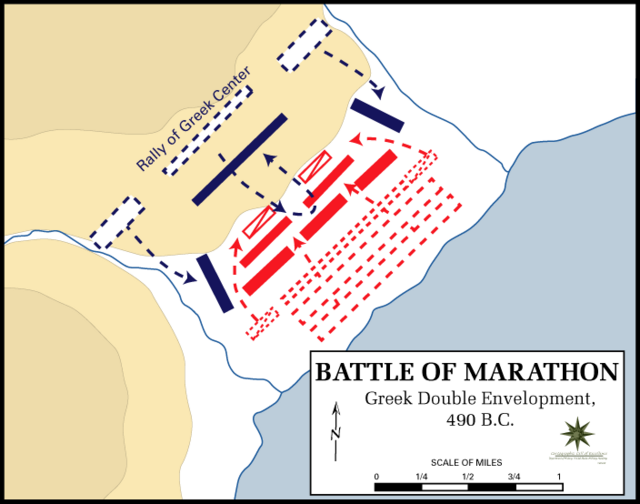Envelopment
military tactic of multiple attacks From Wikipedia, the free encyclopedia
Remove ads
Envelopment is the military tactic of attacking the enemy's flank or rear while keeping the enemy's attention focused on its front by the use of diversionary attacks.[1] The envelopment makes the enemy fight in a direction for which it is the least prepared.[2] The maneuver requires a flank that can be attacked. Unlike a flanking maneuver, which uses the enemy's forward movement to create an attackable flank, envelopment depends on the enemy's defensive position, any obstacles and the terrain.[2]

Envelopment has both advantages and disadvantages. Advantages include being able to capture or defeat all or part of an opposing army and offering less risk than other offensive maneuvers.[3] Disadvantages include the possibility of an enemy counterattack on the weakened center or on the other flank.[3]
Remove ads
Types of envelopment
- Turning movement is to "turn" the enemy from his defensive position and force it to act.[1]
- Single envelopment is an attack on one flank or the enemy rear from one direction while holding their attention to its front.[4]
- Double envelopment, also called a pincer movement, requires three forces. One holds the center, and the other two attack the right and left flanks.[4] Once both flanking attacks reach the rear, the enemy is encircled.
- Vertical envelopment is an envelopment from the sky.[5] First thought of by Benjamin Franklin, it was not practical until the invention of the airplane.[5] Vertical envelopment uses paratroopers or other soldiers that arrive by air on the enemy's flank or rear.[5]
Remove ads
Historic examples
Famous examples of the single envelopment include Alexander the Great, who used it at the Battle of Gaugamela in 331 BC.[6] Robert E. Lee used the tactic during the American Civil War at the Battle of Chancellorsville in 1863.[6] During World War II, German General Erwin Rommel used it successfully at the Battle of Gazala, which led directly to his capture of Tobruk in 1941.[6]
Some of the famous double envelopments include Hannibal's defeat of the Roman army in 216 BC.[6] During the American Revolutionary War, American General Daniel Morgan used it in 1781 successfully against British General Banastre Tarleton and caused many of the British soldiers to surrender.[6] In the 1944 Falaise Gap, during Operation Overlord of World War II, German troops were caught in a double envelopment by British and American forces .[6]
Remove ads
References
Other websites
Wikiwand - on
Seamless Wikipedia browsing. On steroids.
Remove ads
